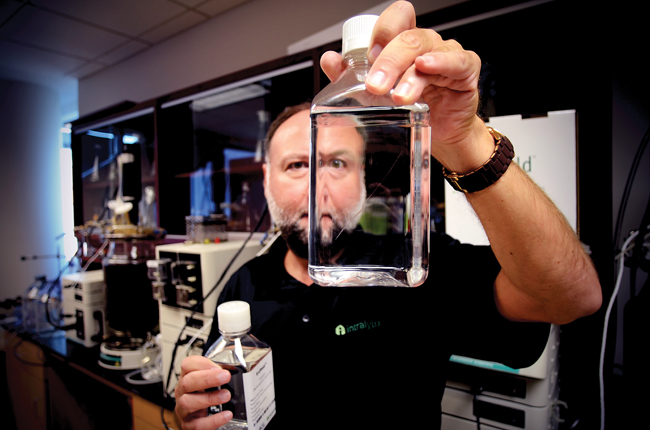

By David Richardson of urbanitebaltimore.com August 29, 2011
The 1904 Bulletin of the Johns Hopkins Hospital holds an early hint of the curative powers of Maryland's waters. According to the Bulletin, during Colonial times, one Captain Dent from St. Mary's County remarked about some "cool springs" located on his properties that were reputed to have healing powers. Authorities at the time dismissed his correspondence as "an idle letter not worth an answer." But when, in the winter of 1697 to 1698, the southern counties were "visited by a severe pestilence of some kind," the springs "wrought many Wondorfull and Signall Cures." How is still a mystery.
That was a few centuries ago, and the cures in St. Mary's County are largely forgotten. However, today's scientists are taking a close look at the waters hereabouts, and discovering-or rediscovering-some true healing potential.
The heart of the action is in the Center of Marine Biotechnology overlooking the Coast Guard slip at the Inner Harbor. There, in the headquarters of Intralytix Inc., the company's chief scientist, Alexander "Sandro" Sulakvelidze, and a staff of eleven are trying to leverage the potential of tiny organisms called phages. Phages, Sulakvelidze says, hold the key to treatments that "can save a lot of lives." And, he believes, the quayside location may someday pay off in a big way.
Chances are, you've never heard of phages, which is surprising: "Phages are the most ubiquitous and populous organisms on the planet," Sulakvelidze says. Each time you take a bite of a fresh fruit or vegetable, you probably choke down millions of them, he says, and it doesn't matter if you rinse off your snack beforehand because phages are in the water too-up to two hundred million of the little buggers in a single milliliter.
This is a little startling, considering that phages are actually viruses. The good news is that unlike the viruses that can make people sick, phages don't attack the human body; they attack germs. For over three billion years-since the beginning of life itself-phages have been locked in mortal combat with bacteria. Each type of phage, Sulakvelidze explains, is fine-tuned by nature to prey on one specific type of bacteria, and to do it with ruthless efficiency. And unlike an antibiotic, which wipes out all manner of bugs, it does this while leaving other bacteria-including those that are harmless or even beneficial to humans-intact. "This makes them extremely valuable for use in medical practice for fighting infection," Sulakvelidze says.
Phages did, in fact, experience a brief moment in the medical limelight in the 1920s, when they were used to treat dysentery. However, they didn't always seem to work. Caregivers at the time didn't have a reliable means to distinguish the different kinds of bacteria in order to match them with the right phages. As a result of these apparent failures, when antibiotics came along in the 1930s with the ability to reliably destroy many kinds of bacteria at once, Western medicine turned its back on phages. By the time the Cold War dusted up, the study and use of phages had retreated behind the Iron Curtain.
Sulakvelidze's birthplace of Tbilisi, in the former Soviet Republic of Georgia, became the world's center for phage research. He remembers taking phages to treat an illness he had as a child. "Everyone I knew took them," he says. "It was something everyone did-and still does."
With the breakup of the Soviet Union during the early 1990s, the medical establishment throughout Eastern Europe was thrown into chaos. Sulakvelidze, a young PhD, having advanced to deputy director of his country's Center for Disease Control by the age of 27, won a fellowship to further his studies in the United States. He chose the University of Maryland Medical School in Baltimore, where he did post-doctorate work in molecular genetics and microbiology.
Several years ago, a colleague from a Baltimore hospital approached him, grief stricken over losing a patient to a rampant antibiotic-resistant infection. Sulakvelidze asked why the phages didn't work. "I can still remember the look on his face," Sulakvelidze says. His friend, Dr. Glenn Morris, had been completely unaware that phage therapy could have stemmed the infection. Likewise, Sulakvelidze was surprised to learn that a potentially life-saving procedure, commonly available in the former Soviet Union, would be unknown at even the most advanced medical facilities in the United States.
"It was a life-changing moment," Sulakvelidze says. The two doctors partnered to found Intralytix to bring the technology stateside.
Phage remedies were not an easy concept to sell. "I was laughed at numerous times," Sulakvelidze says. "I'd talk to physicians, and either they'd never heard of it, or they'd say 'Weren't those tried before and it didn't work?' or, 'There's no way you can get viruses approved for therapeutic use in this country.'"
After years of wrestling with the Western medical establishment and government health agencies, Intralytix changed course to look into the agricultural market, and in 2006 received the go-ahead from the United States Food and Drug Administration to use phages to eradicate listeria, a serious disease-causing bacteria, from food before it is sold in stores. This year the FDA gave Intralytix the green light to use a separate phage cocktail to do the same for E. coli. With labs at Aberdeen now gearing up to produce the food safety preparations, Sulakvelidze says he is turning back to human cures, working on a project to fight shigella (a form of dysentery) with the support of the U.S. Army's Research Office.
Sulakvelidze is not the only one who believes in the remarkable potential of phage therapy. Alan Wright, a former Baltimore emergency room physician, says hospital units sometimes "get contaminated with some pretty dangerous bacteria that can be extremely difficult to eradicate. I wouldn't be surprised if phages are called upon in the future to rehabilitate intensive care units.
"As we continue to create more and more [antibiotic-]resistant bacteria," Wright adds, "it could become a mainstream treatment for some incredibly resistant strains."
Elizabeth Kutter, who heads the Evergreen State University Phage Biology Lab in Olympia, Washington, says phages have been shown to be effective in combating the well-known antibiotic-resistant bacteria MRSA (multiple resistant Staphylococcus aureus). "Phage therapy could provide a good complement to established medical practice," Kutter says.
But if bacteria can develop resistance to antibiotics, what's to say they couldn't find an end-run around phages? Sulakvelidze concedes that bacteria can eventually outsmart particular phages; that's why he uses phages in combinations. He says he has yet to see a bad bacteria survive his specially prepared phage cocktails.
If that were to happen, however, he's in a good spot to find a replacement cure. "We get a lot of our phages from the Chesapeake Bay," Sulakvelidze says. "It's very easy to run down to the Inner Harbor and go for it-and see if you can find some phages."






